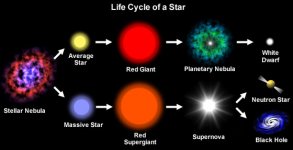This would mess up our previous measurements of cosmic distances and put into doubt the accelerating expansion
of the universe and hence the existence of the Dark Energy hypothesised to explain it. Am I right?
Yes it seems so, if this holds up.
Sounds like the title of a Sci-Fi novel.vacuum tubes in space
I've found an illustration for its cover!
Attachments
Sounds like the title of a Sci-Fi novel. I've found an illustration for its cover!
And no getter needed.
How was it regarded as the standard to begin with?Reading through that link, I take it that that a Type 1a Supernova can no longer be regarded as the 'standard candle' used for the measurement of cosmic distances.
If I understand it correctly, the brightnesses of T1a supernovae have recently been found to depend on how young they are - i.e. how far back in time we can observe them.
All T1a supernovae are therefore not of a standard brightness as previously assumed.
This would mess up our previous measurements of cosmic distances and put into doubt the accelerating expansion of the universe and hence the existence of the Dark Energy hypothesised to explain it.
Am I right?
Let's input some appropriate music and find out!So ...if the the Space is a Vacuum tube how does it sound?
Attachments
A type 1a supernova is produced by an exploding white dwarf star.How was it regarded as the standard to begin with?
Now white dwarf stars all have a standard mass, so the brightness of the supernovae they produce is predictable.
Since brightness decreases with distance, we can use the difference between the observed brightness of a type 1a supernova and its predicted brightness to calculate how far away it is.
That's why type 1a supernovae are called 'cosmic mile markers' or 'standard candles'.
How do we know all white dwarf stars have a standard mass? How do we know they all have the same composition?A type 1a supernova is produced by an exploding white dwarf star.
Now white dwarf stars all have a standard mass, so the brightness of the supernovae they produce is predictable.
Since brightness decreases with distance, we can use the difference between the observed brightness of a type 1a supernova and its predicted brightness to calculate how far away it is.
That's why type 1a supernovae are called 'cosmic mile markers' or 'standard candles'.
It's all about 'stellar evolution'.How do we know all white dwarf stars have a standard mass? How do we know they all have the same composition?
Too much tutoring to go into here, so see: White dwarf - Wikipedia
Our Sun (an average star) will evolve into a red giant, eject a beautiful nebula and end up as a white dwarf.
Attachments
Check out this highly readable article from NASA: White Dwarfs - IntroductionHow do we know all white dwarf stars have a standard mass? How do we know they all have the same composition?
It describes a typical white dwarf as being as massive as our Sun and being composed of carbon.
I just read recently new evidence black holes do not actually exist.
As seen by an external observer, nothing ever falls into a black hole, even though it has a normal gravitational field.
In that sense, a black hole may not actually have an interior. If it doesn't, then where is it?
Last edited:
There are many pieces of evidence that point toward our current understanding of stellar evolution.Has this process been observed or is it educated hypothesis?
Read about them here:Stellar Evolution | aavso.org
That's interesting, considering our recent success in imaging one - or at least its silhouette.I just read recently new evidence black holes do not actually exist.
How Scientists Captured the First Image of a Black Hole - Teachable Moments | NASA/JPL Edu
Where can I find this new evidence?
I think LIGO observed several black hole mergers already.As seen by an external observer, nothing ever falls into a black hole, even though it has a normal gravitational field.
Yes, the enormity of the universe is beyond our comprehension and black hole collisions are actually quite common.I think LIGO observed several black hole mergers already.
Scientists can detect the gravitational waves caused by these mergers and at least ten have been detected in the past three years.
There's more information about the Laser Interferometer Gravitational-wave Observatory or LIGO here: LSC - LIGO Scientific Collaboration
- Status
- This old topic is closed. If you want to reopen this topic, contact a moderator using the "Report Post" button.
- Home
- Member Areas
- The Lounge
- vacuum in space


